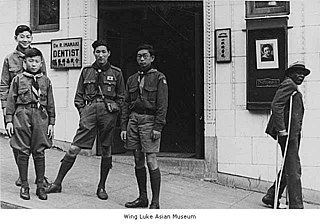
Scouting in Minnesota has a long history, from the 1910s to the present day, serving thousands of youth in programs that suit the environment in which they live.

Scouting in Washington has a long history, from the 1910s to the present day, serving thousands of youth in programs that suit the environment in which they live.

Scouting in Iowa has a long history, from the 1910s to the present day, serving thousands of youth in programs that suit the environment in which they live.

Scouting in Missouri has a long history, from the 1910s to the present day.

Scouting in Arkansas has a long history, from 1913 to the present day, serving thousands of youth in programs that suit the environment in which they live.

Scouting in Indiana has a long history, from the 1910s to the present day, serving thousands of youth in programs that suit the environment in which they live.

Scouting in Ohio has a long history, from the 1908 to the present day, serving thousands of youth in programs that suit the environment in which they live.

Scouting in West Virginia has a long history, from the 1910s to the present day, serving thousands of youth in programs that suit the environment in which they live.

The Greater Saint Louis Area Council of the Boy Scouts of America was formed in 1911 and is based in St. Louis, Missouri. The council serves Scouts in the St. Louis Metro area, southeast Missouri, and southern and central Illinois.

Circle Ten Council is a Boy Scouts of America (BSA) chartered council in central north Texas and a portion of Oklahoma. It encompasses all or parts of: Camp, Collin, Dallas, Delta, Ellis, Fannin, Franklin, Grayson, Henderson, Hopkins, Hunt, Kaufman, Lamar, Morris, Navarro, Rains, Red River, Rockwall, Titus, and Van Zandt counties in Texas as well as Bryan, Choctaw, McCurtain, and Pushmataha counties in Oklahoma. Founded in 1913 and based in Dallas, approximately 50,000 youth and 15,000 adults participate in Scouting through the council each year. The council has four camps - Camp Wisdom, Camp James Ray, Clements Scout Ranch / Camp Trevor Rees-Jones and Camp Constantin / Jack D. Furst Aquatics Base. The Order of the Arrow is represented by Mikanakawa Lodge.

The Virginia Headwaters Council (VAHC) is the local council of the Boy Scouts of America (BSA) that serves Scouts in areas of the Shenandoah Valley in Virginia and West Virginia and areas of central Virginia.

Mississippi Valley Council is headquartered in Quincy, Illinois, and is served by Black Hawk Lodge, Order of the Arrow. This council serves Scouts in Illinois, Missouri and Iowa. In 1994, Saukee Area Council merged with Southeastern Iowa Council to form Mississippi Valley Council. The Mississippi Valley Council is one of 22 local Scouting councils in Illinois.

The Winnebago Council is a council of the Boy Scouts of America (#173). The Winnebago Council serves Scouts BSA, Cub Scouts, adult volunteers and Venturers in 17 counties located in North Central Iowa. Including: Black Hawk, Grundy, Butler, Franklin, Wright, Hancock, Winnebago, Worth, Cerro Gordo, Mitchell, Floyd, Bremer, Chickasaw, Howard, Winneshiek, Fayette, and Buchanan.

The Northeast Georgia Council, a local council of the Boy Scouts of America, provides scouting programs for 26 counties in northeastern Georgia, and serves more than 25,000 youth in Cub Scouting, Boy Scouting, Varsity Scouting, Venturing, Exploring, and in-school Learning for Life.

The Mid-America Council of the Boy Scouts of America offers programs in 58 counties in Nebraska, Iowa and South Dakota. The Mid-America Council was formed from a merger of the Covered Wagon Council and the Southwest Iowa Council in 1965. The first recorded Council in the area was in 1918 as the Omaha Council. In 2000 the council merged with the Prairie Gold Council that had been located in Sioux City, Iowa.

Water and Woods Field Service Council was a field service council of the Michigan Crossroads Council that served youth in the central and northeastern Lower Peninsula of Michigan. The Council was headquartered in Flint, Michigan, with service centers located in Auburn, Lansing, and Port Huron. The Water and Woods Field Service Council was the result of a merger in 2012 of Lake Huron Area Council, Blue Water Council, Tall Pine Council and Chief Okemos Council.
The Bay-Lakes Council is the Boy Scouts of America (BSA) council serving eastern Wisconsin and the Upper Peninsula of Michigan. Headquartered in Appleton, Wisconsin, it is geographically one of the largest local BSA councils. Bay-Lakes Council #635 was formed on July 1, 1973, the product of a merger between six east Wisconsin councils. The council is served by Kon Wapos Lodge #635 of the Order of the Arrow.
The Miami Valley Council is a local council of the Boy Scouts of America and serves Darke, Preble, Miami, Shelby and Montgomery counties in Ohio.
The Great Sauk Trail Council is a defunct local council of the Boy Scouts of America which was based out of Ann Arbor, Michigan serving Livingston County, Washtenaw County, Jackson County, Lenawee County, Hillsdale County, Monroe County, Eastern Calhoun County, and the city of Flat Rock, in Michigan.
Greater Tampa Bay Area Council serves Scouts in West-Central Florida with the council headquarters in Tampa, Florida. Youth are served in the following nine counties: Citrus, Hardee, Hernando, Highlands, Hillsborough, Pasco, Pinellas, Polk and Sumter. Greater Tampa Bay Area Council was formed on May 1, 2016 by the merger of Gulf Ridge Council with West Central Florida Council.

















